News:
Hitler wanted this painting for his personal museum — now it’s promised to the MFA
By Malcolm Gay
The museum and donors have reached a resolution with the heirs of two Jewish art dealers to retain a 17th-century Dutch painting by Adriaen van Ostade.
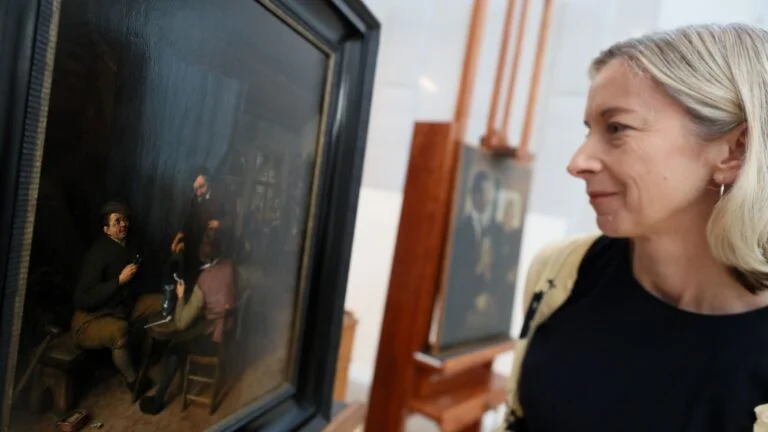 Victoria Reed, the MFA's senior curator for provenance, examined the painting by Adriaen van Ostade.
Victoria Reed, the MFA's senior curator for provenance, examined the painting by Adriaen van Ostade.
Among the countless artworks taken by the Nazis during World War II was a humble interior scene by a 17th-century Dutch painter intended to hang in Adolf Hitler’s Führermuseum, the dictator’s unrealized vanity project in Austria meant to house Europe’s most celebrated works of art.
History decided otherwise, and the painting, its past obscured by postwar events, ended up in private hands, with no hint of the extraordinary story of human struggle it would tell.
Eight decades later, that painting is on display at the Museum of Fine Arts, its provenance finally revealed by an intense research effort by a persistent curator.
It is a remarkable turn of events, with a remarkable story behind it, one that exemplifies the excruciating moral calculus faced by many Jewish people as they fled persecution and death during World War II. In this case, a desperate Jewish art dealer who evidently betrayed his business partner by selling precious artworks to the Nazis.
The painting’s public unveiling comes after the MFA and collectors Susan and Matthew Weatherbie, who acquired the work in the 1990s, reached an agreement with the dealers’ heirs to retain the genre painting by Adriaen van Ostade.
The agreement, which involves an unspecified cash payment to the heirs by the museum and the Weatherbies, caps six years of research and negotiations between the parties. It allows the Weatherbies to retain ownership of the work, which they pledged to the museum as part of a larger promised gift of Dutch and Flemish paintings in 2017.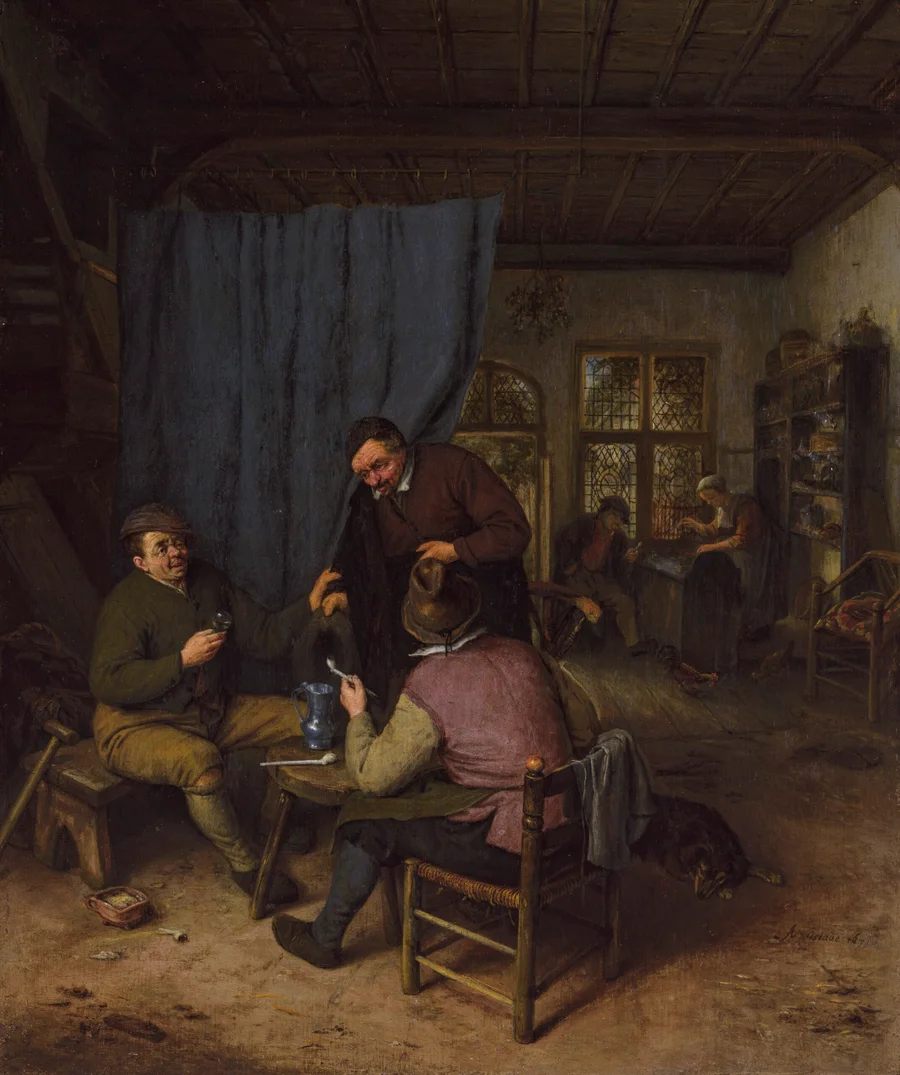
Adriaen van Ostade, “Customers Conversing in a Tavern,” 1671, oil on panel. – Courtesy Museum of Fine Arts, Boston
The oil-on-panel work, “Customers Conversing in a Tavern” (1671), shows a modest interior scene with two groups of people who share the room with a sleeping dog and barnyard fowl. The MFA is exhibiting the painting in its galleries for the first time this weekend, pairing it with other works by Ostade and his student Cornelis Bega.
Director Matthew Teitelbaum called the resolution “an important moment for the MFA.”
“This case stands out as an example of how crucial proactive due diligence and cooperation is in our provenance work,” he said in a statement. “From the moment we began to uncover the circumstances of the painting’s ownership history, the Weatherbies have been committed to resolving this claim.”
The agreement comes as museums around the world are under pressure to account for contested objects in their collections. The MFA has resolved a number of such disputes in recent years, including last year’s return of a 17th-century Dutch painting looted by the Nazis. The arrangement followed earlier MFA settlements over a group of porcelain figurines sold amid Nazi persecution and a group of looted Nigerian artifacts.
Victoria Reed, the museum’s senior curator for provenance, said she first became aware of the Ostade painting in 2017 while researching the landmark gift to the museum of Dutch and Flemish paintings from the Weatherbies and well-known Golden Age collectors Eijk and Rose-Marie van Otterloo.
It was the only painting in the group that raised a red flag, said Reed, who discovered it had been listed on a database maintained by the German Lost Art Foundation. She added that, after consulting with the Weatherbies, the museum chose not to list the painting when it announced the promised gift, which included roughly 30 of the couple’s artworks.
“There are so many gray areas,” she said. “I needed to look further.”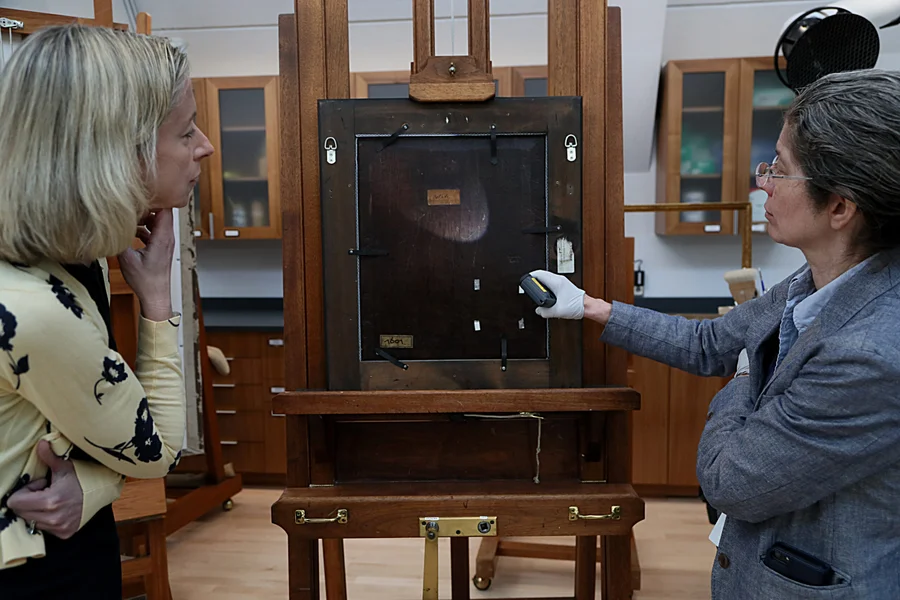
Victoria Reed (left), senior curator for Provenance at the MFA, and Rhona MacBeth (right), director of conservation and scientific research, show the back of a painting that was once destined for Hitler’s museum
Combing through files spread across three countries, Reed discovered the painting had belonged to Paul Graupe, a well-known Jewish auctioneer in Berlin whose business was Aryanized, or taken over by non-Jews during the Nazi era.
Graupe fled to Paris in 1937, where he opened an art gallery working with Arthur Goldschmidt, a fellow Jewish art dealer who’d also fled Nazi Germany.
The pair had known each other in Berlin, but months before France entered the war in September 1939, Graupe fled to Switzerland. He left his large inventory of paintings — including the Ostade — in Paris, where Goldschmidt moved them to a storage facility just before the Nazis took the capital in June 1940.
With his paintings stranded in occupied Paris, Graupe pressed Goldschmidt to smuggle as many artworks as possible out of France — a daunting task for the Jewish Goldschmidt, who’d fled to the country’s south and could not travel freely to Paris.
The saga is recounted in a report Reed discovered from the US Treasury Department, which later investigated Graupe’s business dealings when he sought to import paintings to the United States.
The report, which includes translations of several documents, recounts how Goldschmidt discussed eight paintings in a cable to Graupe in March 1941. Goldschmidt said he had four of the paintings in hand, two were still in Paris, and two — including the Ostade — were “on their way.”
What Graupe didn’t know at the time — and his partner never told him — was that Goldschmidt was working with Hitler agent Karl Haberstock, an art dealer who could move freely between the occupied and unoccupied zones of France.
Goldschmidt ultimately sold two of Graupe’s paintings — including the Ostade — to Haberstock, a sale that’s recorded in a handwritten receipt from February 1941.
Reed added that Haberstock in turn sold the artworks to the Reich Chancellery: “These are the paintings that get selected for Hitler’s museum.”
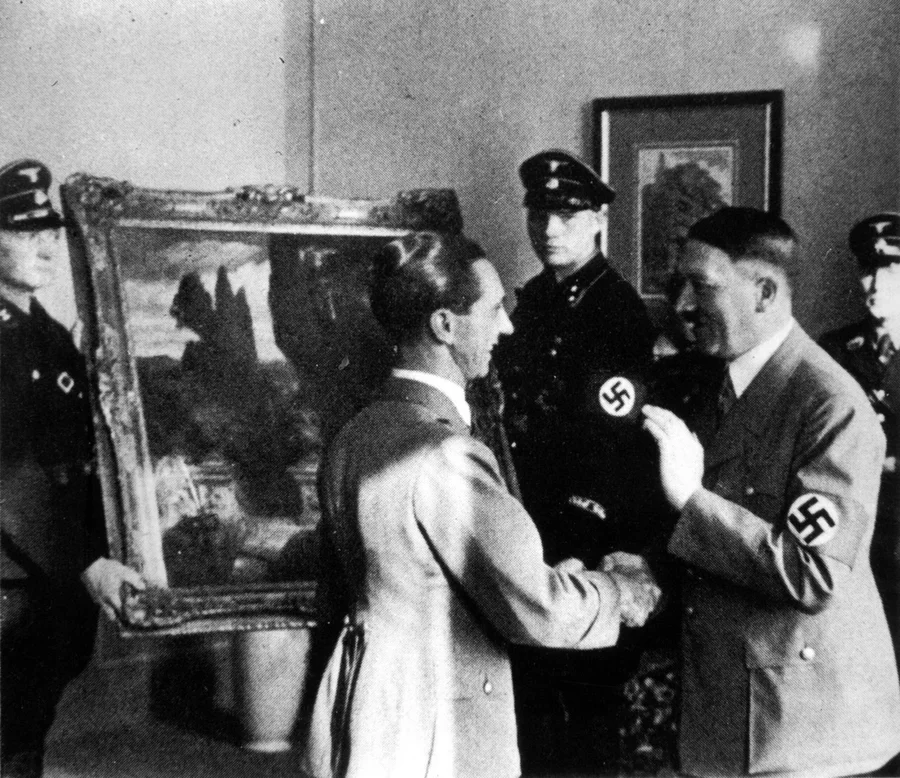 Hitler and Joseph Goebbels looking at works of art stolen from the Italians.
Hitler and Joseph Goebbels looking at works of art stolen from the Italians.
Graupe, who by then was in Portugal arranging travel to the United States, repeatedly cabled Goldschmidt, eventually reporting him to French officials for “wrongfully holding property.”
The accusation angered Goldschmidt, who demanded Graupe retract the accusation and acknowledge his ownership stake in the paintings.
“What is the matter with you,” he wrote his estranged partner in March 1941. “How can you who spent the entire war in neutral countries, safe and unharmed, without any privations . . . dare to mobilize the authorities against me.”
Graupe eventually relented, and Goldschmidt arranged shipment of four paintings to him in New York before fleeing to Cuba in the summer of 1941.
A few months later, Goldschmidt wrote Graupe recounting an elaborate tale involving the paintings, gangsters, and ransoms. He claimed he’d had to sell the Ostade painting to pay off smugglers and to get the rest of the artworks, adding he later sold three other paintings as well.
What Goldschmidt did not say was that he’d sold some of them to Nazis. Rather, he asked his business associate if he “could keep the balance” on one of the paintings “until the final settlement of the mutual accounts.”
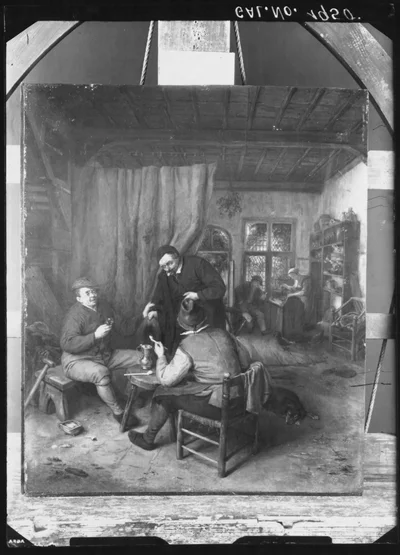
An image of the Ostade painting after it was recovered by Allied forces and taken to the Munich Central Collecting Point for artworks appropriated by Germany during World War II.
“It’s not a black-and-white story,” said Reed, who added Graupe ended their business relationship a few months later, angry that Goldschmidt had sold gallery stock without his approval. “It’s hard to neatly categorize the decisions of a Jewish emigre art dealer, who is living in the south of France, trying to survive and make his way out of Europe.”
Goldschmidt remained in Havana for several years, eventually returning to Europe, where he died in Switzerland in 1960.
Graupe vigorously pursued property claims after the war. But although he initially listed the Ostade among his claims, for reasons unknown he later removed it. It’s unclear whether he ever discovered what happened to the painting before he died in Germany in 1953.
In fact, Allied forces had recovered the painting from the Austrian Altaussee salt mine in 1945. It went through the Munich Central Collecting Point and was eventually shipped back to France, where, unclaimed, it was auctioned off in 1951.
The painting circulated through the opaque private art market for several decades before the Weatherbies purchased it via a private sale in 1992.

MFA donors Matthew and Susan Weatherbie.
Armed with this information, the museum and the Weatherbies approached the heirs of Goldschmidt and Graupe, who’d jointly filed the database claim.
Still, many questions remain. How did Goldschmidt get the paintings out of Paris? Did Graupe ever learn the fate of the Ostade? And did the men ever smooth things over?
The heirs of both men declined an interview request, as did their attorney.
But the ethical dimension of the case is clear, said Reed.
“If we see this as Paul Graupe’s property, it’s pretty clear this is Jewish-owned property that was sold during the Nazi era, and he was never compensated,” she said. In terms of Goldschmidt, Reed said, “Was he using the money from this painting to survive?”
Teitelbaum said it’s not unusual to have so many unanswered questions about the ownership history of a centuries-old object that changes hands during times of great upheaval.
“We always have to balance the loss of witnesses and documentation through the passage of time with judgments about historical circumstances,” he said. “I’m proud to say that years of meticulous research and a thorough investigation led us to this outcome.”
In a statement, the Weatherbies said they were “happy that these longstanding ownership issues have been resolved so amicably.”
The painting, which was previously titled “Peasants Conversing in an Interior,” has had its name updated by the museum and the Weatherbies and will now be exhibited under the more neutral “Customers Conversing in a Tavern.”
It will also be accompanied by a wall label describing its tortuous path to the MFA.
“I think it’s wonderful that we can put the painting on view,” said Reed, “because, really, the goal in redressing all of these material losses is, yes, to right a wrong, but it’s also to preserve the memory of the people who lost this property.”
https://www.boston.com/news/arts/2023/06/11/hitler-painting-personal-museum-promised-to-mfa/


